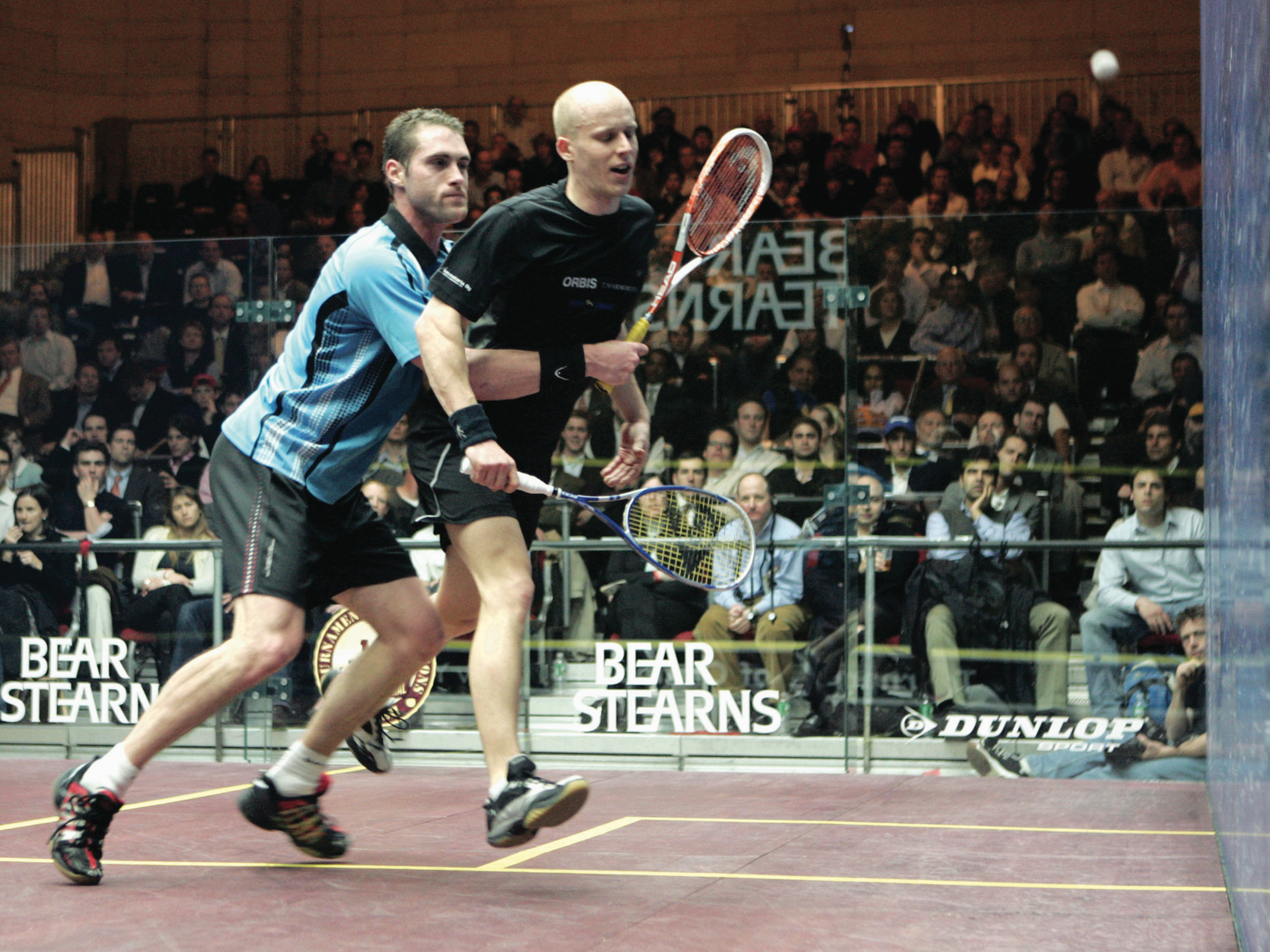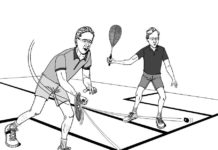![“[If] the outgoing striker’s attempt to clear prevented the incoming striker from moving directly to the ball in order to play it, [and] assuming that the incoming striker would have been able to reach the ball and play it, but was blocked from doing so by the outgoing striker’s failure to clear properly, it is a stroke to the incoming striker.” Such was the case in the 2007 Tournament of Champions when David Palmer was run into by a “clearing” Olli Tuominen.](https://newsm.wpengine.com/wp-content/uploads/2014/11/Screen-Shot-2014-11-20-at-3.43.08-PM-1024x767.png)
By Rod Symington, WSF Referees and Rules Committee
I don’t usually like answering questions of the “What if…?” variety, because the scenario described by one player is almost always different from the other player’s recollections. I usually say: “You’ll have to show me the video”—which, of course, is not available. That’s how I keep my perfect record!
However, when the Editor of Squash Magazine sends you a “What if…?” question, and when the scenario he describes both happened to him and is a common one on the squash court (and a frequent cause of arguments), an answer should be attempted (with apologies to the opponent whose version of the events was not available at press-time).
Here is the scenario:
A player hits a ball straight down the right wall from the back of the service box. That player then moves directly left (to “clear”), but his opponent, who was at the T, steps directly to the right to volley the ball that is now about 6 inches from the side wall in the middle of the service box. While stepping over to volley the ball, he runs into the original striker who is still in the service box, so only a couple feet from the side wall, and who “is still trying to clear”. Though the incoming player did not verbally ask for the let, because he’d taken a shoulder into his chest while reaching to volley the ball, the request for the let is pretty obvious; as is the expectation of a stroke. The player clearing argues that it can’t be a stroke because, (a) the player didn’t actually ask for the let, and (b) the player couldn’t play the ball. The incoming player argues that (a) he didn’t ask for a let because he was run into pretty hard (so then said, “let” after the collision), and (b) the only reason he couldn’t play the ball was because the original striker was in the way.
As this “argument” continued, it became clear that the interpretation by the original striker was this: because the player attempting to volley the ball couldn’t actually hit the ball at the time of the collision, it can’t be a stroke; “it’s the definition of a let,” he said. The problem is that the only reason the player couldn’t volley the ball was because his opponent ran into him as he was reaching out to hit the ball (that was clearly within reach as the collision took place inside the service box).
I am sure this scenario and the ensuing “discussion” must sound familiar to a lot of readers. The situation arises frequently, and the outcome is actually easy to deduce if the correct principles are applied.
First, after hitting the ball, the outgoing striker has a duty to clear—but to clear in such a direction that the incoming striker has direct, unobstructed access to the ball. Thus after hitting the ball, the outgoing striker does not have the right to go straight back to the T, if that means that the incoming striker’s direct access to the ball is blocked.
In the above scenario, the outgoing striker’s attempt to clear prevented the incoming striker from moving directly to the ball in order to play it. Assuming that the incoming striker would have been able to reach the ball and play it, but was blocked from doing so by the outgoing striker’s failure to clear properly, it is a stroke to the incoming striker.
But what, as the outgoing striker here argued, if the incoming striker, on encountering interference, does not call “let”? Ideally, a player should call let, but the Rules (12.5.2) state: “The player must appeal either immediately [as] the interference occurs or, when clearly not continuing play beyond the point of interference, without undue delay.” This Rule applies in the scenario described above.
Note that we have not considered whether the incoming striker would have been able to make a reasonable swing at the ball, or whether he would have had the entire front wall to hit to (two further things the outgoing striker must provide him with). We do not need to go that far: As soon as the player is prevented from gaining direct access to the ball by the outgoing striker’s failure to clear, the point is decided.
Blocking is the cardinal sin of squash. The King of the T (T-Rex) has to be made extinct—and the Rules of Squash provide the means to achieve that goal. (I expect the Editor now to double my pay.)





